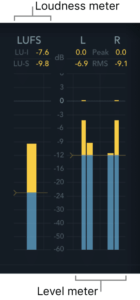Have you ever wondered why some music tracks sound louder than others, even when played at the same volume? This is because music tracks have different loudness levels, which can make some tracks sound louder or quieter than others. This is where LUFS, or Loudness Units relative to Full Scale, comes into play.
What is LUFS?
LUFS is a standard that measures the perceived loudness of the audio. It is based on the human ear’s response to sound and is designed to provide a consistent loudness level for all audio, regardless of the device it is played on. LUFS was developed to solve the problem of inconsistent loudness levels in audio, which made it difficult for listeners to enjoy music at a consistent volume level.
How is LUFS Measured?
LUFS is measured in decibels (dB), and it takes into account not only the volume of the audio but also the frequency and the length of time it is played. This means that a short, loud sound will have a different LUFS value than a longer, quieter sound with the same volume.
Why is LUFS Important for Music Production?
For music producers and audio engineers, LUFS is an important tool for ensuring that their tracks have consistent loudness levels. This is because LUFS takes into account the perceived loudness of audio, which is what listeners actually hear. This means that music producers and audio engineers can use LUFS to make sure that their tracks sound good on all devices, from headphones to speakers to car audio systems.
What is the Target LUFS for Music?
The target LUFS for music varies depending on the genre and style of music, but generally, the target LUFS for most music is between -14 LUFS and -16 LUFS. This range provides a good balance between loudness and dynamic range, allowing for the music to sound loud and punchy without becoming too compressed and losing its dynamic range.
How to Measure LUFS in Music Production
Measuring LUFS in music production is simple and straightforward. Most digital audio workstations (DAWs) come with built-in LUFS meters, and there are also many free and paid LUFS meter plugins available for download. Simply load the plugin into your DAW and play back your track to see its LUFS level. You can then make adjustments to the volume and dynamic range of your track to achieve the desired LUFS level.
Conclusion
In conclusion, LUFS is a crucial tool for music production and audio engineering. It provides a consistent loudness level for audio, making sure that tracks sound good on all devices and at all volume levels. By using LUFS, music producers and audio engineers can ensure that their tracks sound loud and punchy without losing their dynamic range. So the next time you’re working on a music track, make sure to use LUFS to make sure it sounds its best.
Get in touch with Neptune Mastering and see how we can make your audio sound better!

